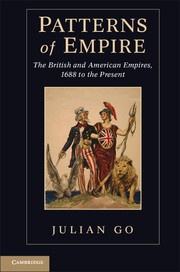Book contents
- Frontmatter
- Contents
- Preface and Acknowledgments
- List of Tables
- List of Figures
- Introduction
- 1 Imperial Paths to Power, 1688–1939
- 2 Colonial Rules
- 3 Hegemonies and Empires
- 4 Imperial Forms, Global Fields
- 5 Weary Titans
- 6 The Dynamics of Imperialism
- 7 Conclusion
- Appendix Notes on Data
- Archives and Abbreviations
- References
- Index
4 - Imperial Forms, Global Fields
Published online by Cambridge University Press: 05 June 2012
- Frontmatter
- Contents
- Preface and Acknowledgments
- List of Tables
- List of Figures
- Introduction
- 1 Imperial Paths to Power, 1688–1939
- 2 Colonial Rules
- 3 Hegemonies and Empires
- 4 Imperial Forms, Global Fields
- 5 Weary Titans
- 6 The Dynamics of Imperialism
- 7 Conclusion
- Appendix Notes on Data
- Archives and Abbreviations
- References
- Index
Summary
Colonialism is successful where the subject people are unsophisticated and acquiescent, as in the case of certain South Pacific islanders. Once the dependent people, even if a small minority of them, acquire a degree of worldly wisdom and personal ambition, complications set in. Discontent, resistance, and political psychoses develop.
– U.S. National Security Council 51 (1949)Colonialism is in its twilight hour.
– Erasmus Kloman (1958)In what ways has the U.S. imperial formation differed from Britain's? It is not the lack of overseas colonies. Nor is it that the U.S. colonial empire was more benign or liberal, that the U.S. empire was uniquely informal, or that its citizens refused to speak the empire's name. Rather, one important difference remains. Whereas both the U.S. and British imperial formations involved colonies, and whereas both entailed informal modalities of power – cultivating clients, cajoling enemies, and deploying military force – only the British empire mixed informal and formal tactics during its period of hegemony. In the mid-nineteenth century, the British crafted allies, invaded countries, and employed various other informal tactics while also seizing overseas territory as colonial dependencies. The British state did not seize as many colonies during its period of hegemony as it did during its period of hegemonic ascent (a point to be considered later). Yet it did seize some. Alternatively, during its comparable phase of hegemony, the U.S. empire did not seize multiple new colonies. In 1947, it annexed the former Japanese mandates, but afterward the American state relied exclusively on informal imperialism. Whereas the British empire was formal and informal at once after 1815, the United States empire shifted from formal to informal after 1947.
- Type
- Chapter
- Information
- Patterns of EmpireThe British and American Empires, 1688 to the Present, pp. 133 - 165Publisher: Cambridge University PressPrint publication year: 2011
- 1
- Cited by



